THE American WESTERN
By Jeffrey-Baptiste Tarlofsky
By Jeffrey-Baptiste Tarlofsky
Lesson 3 consists of four sections. In each section
1. Watch the film excerpt
2. Watch the video lecture and then
3. Read the transcript of the lecture
Repeat for each section. For example, in section 2, watch film excerpt #2, watch video lecture #2, and read transcript #2.
レッスン3は4つのセクションから構成されています。各セッションでは、以下の順番で授業を受けてください。
1. 動画(Stagecoach excerpt #1(セクション1の場合))を見てください。
2. ビデオレクチャー(動画)を見てください。
3. レクチャーのテキストを読んでください。
各セクションで上記のステップ(1)から(3)を繰り返してください。
Directed by: John Ford
Produced by: Walter Wanger
Screen play by: Dudley Nichols
Based on: The Stage to Lordsburg 1937 by Ernest Haycox
Starring: John Wayne, Claire Trevor, Thomas Mitchell, John Carrdine, Andy Devine, George Bancroft
Music by: Richard Hageman
Wanger Productions: Distributed by United Artists
Running time: 96 minutes
Budget: $531,374
Box office: $1,103,757
Part 1 Western films frequently contrast the cultures and peoples of the American East and the West. In the opening scenes of John Ford’s Stagecoach we see this contrast immediately. We see Buck in his Western clothes and hat and immediately recognize him as a member of the working class which the vast majority of Westerners were. In contrast to Buck we meet Lucy Mallory in her much higher class clothes. She is not only an officer’s wife, she is a woman from a wealthy family in the East. Look at her hat and contrast it with Buck’s. Buck’s hat has a wide brim to keep the sun out of his eyes because he works outdoors. Lucy’s hat offers her no protection from the sun because as a higher class lady she would not be expected to work and would stay out of the sun as much as possible. They are from different classes, but they are also from different places; East and West. Lucy asks where she can have a cup of tea and Buck tells her she can have coffee at the hotel. Tea or coffee? This is actually a rather important distinction. Today America is a coffee drinking culture for the most part, but some people do drink tea. The history of why we drink coffee instead of tea is fascinating.
Recall that the U.S.A. was originally a group of colonies controlled by England. Back in the seventeenth and eighteenth centuries coffee was actually quite popular in England. There were places called “coffee houses” which were actually places where people gathered not just to drink coffee, but also to discuss ideas. Among the topics they discussed were democracy, the rights of man and other things the King did not like his people discussing. The King soon began to suppress the coffee houses in England. But, they could not suppress the ideas people were talking about. In the American colonies people talked about the fact that they were taxed by the King, but had no representation in the British Parliament.
One of the first acts of rebellion against England in the colonies was the Boston Tea Party. Bostonians dressed up as Indians to disguise their identities and attacked British merchant vessels. They dumped the heavily taxed British tea into Boston Harbor. Thereafter, boycotting British Tea became an important symbol of American patriotism. Americans began to switch to drinking coffee imported from South America rather than tea imported from the British colonies in Ceylon and India. We have been a nation of coffee drinkers ever since.
So, why does Lucy want tea when there is only coffee to drink in the West? It is because she is not only an Easterner, but an upper class Easterner. In America, like Japan, upper class people believed that foreign fashions showed how sophisticated and worldly they were. A lady such as Lucy would be interested in the latest clothing fashions from France, music from Italy, philosophy from Germany and of course the British custom of tea drinking. But in the West the people of all classes drank coffee. We will be talking a great deal more about coffee later in the film and throughout the year.
We next meet more ladies, the ladies of the Law and Order League. They are bringing the “civilized” values of the East to this Western town. They have actually gained control of the town and are driving out people they see as undesirable.
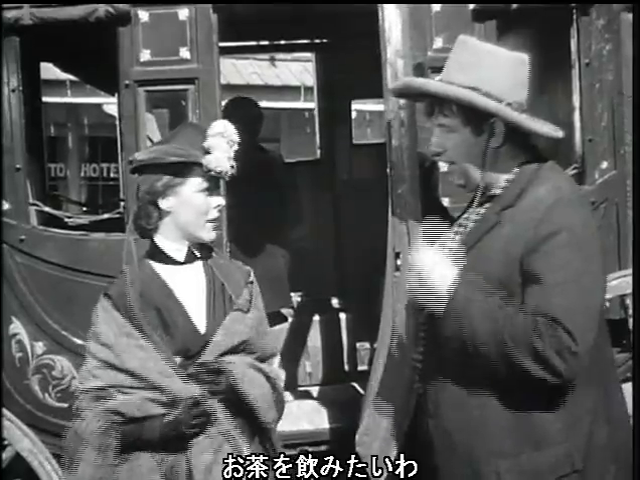
Part 2 Doc and Dallas are being forced to leave the town of Tonto because the Ladies of the Law and Order League don’t want them there anymore. John Ford was famous for his long takes of the Western landscape, but Ford is also a master of using close ups of his characters. In a John Ford film you can actually judge a book by its cover. A good character will have a good face and a bad one will have a bad face.
Look at Images #2 and #3 What kind of faces are these. Can you tell just by looking at his face what kind of character Gatewood is? What about Doc’s landlady? Both are unattractive and even cruel looking faces and that is exactly what these characters are like. In fact, all of the Ladies of the Law and Order League also have cruel faces. In a Ford film, a face tells you who someone is.
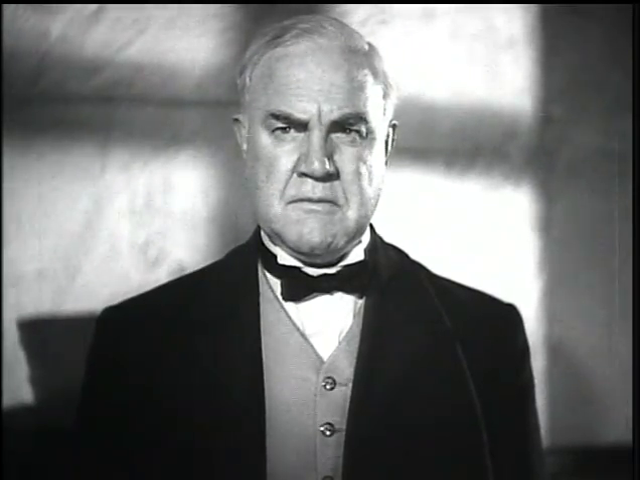
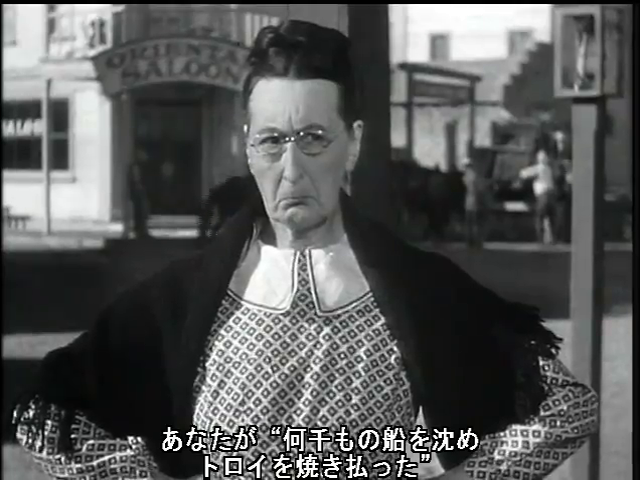
Dallas is a ….. (prostitute). Why is it that nobody ever uses the word “prostitute” in the film? It is because from about 1932 or so the American film industry imposed something called “The Production Code” on all films shown in America. This was actually a form of self-censorship by Hollywood that lasted until the 1960s. There were many things that could not be shown or said in the movies. For example, you could not show blood. This is why when people are shot in westerns they fall down dead, but we see no blood. According to the production code you could not even use the word “prostitute”. But there were many other rules as well. You could not show a husband and wife in bed together. You could not show any romantic relationships between different races, especially between Blacks and Whites. You could not show any homosexual relationships at all. You could not criticize the clergy, government or the police. You could not make a film about drug use. Yet, even with all these restrictions, John Ford made a film that feels like it is about real people with real problems, including these “undesirables”; an alcoholic and a prostitute. Where could such people go to be free of social prejudice? They went to the West, of course, the Wild West beyond the frontier. Now watch excerpt #3 and look at Image #4.
Part 3 Ford has so far provided us with an almost complete cast of Western characters. There are the undesirables of one sort and another, Dallas the Prostitute, Doc the Drunk, and also Hatfield the Gambler. But there are also the men who ride on top of the stagecoach; Buck the driver who is a simple western working man and Curly the Marshall, a lawman. There are also the Easterners who have come to the west; The officer’s wife, Lucy, and the whiskey salesman, Mr. Peacock. Gatewood the Banker joins the group as they are leaving the town. Stagecoach is about what happens to all these people when they cross the frontier which is actually shown as a physical boundary.
Look at Image #4. This is a wonderful and meaningful shot Ford gives us. The gate is the boundary marker between the town of Tonto which has become “civilized” and “easternized” and the Wild West which we see as a long road through open country with a looming mountain in the distance.
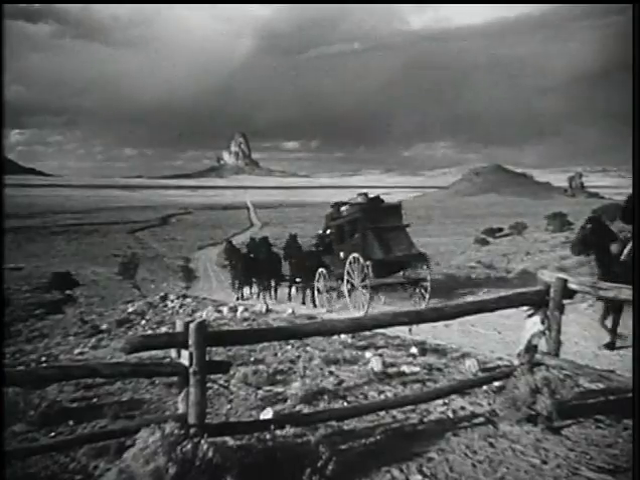
Part 4 Another boundary is crossed, a river. Crossing water always has a powerful symbolic meaning. For example, the ancient Greeks believed that a river divided the world of the living from the world of the dead. There is also the idiom “Crossing the Rubicon” which means to pass a point of no return, and refers to the Roman General Julius Caesar‘s army’s crossing of the Rubicon River in 49 BC. Immediately after the stagecoach crosses the river we hear a rifle shot and meet the star of the film, John Wayne, in his first starring roll. Ford zooms in for a closeup so fast that his camera loses focus and it comes to rest on a face he will explore again and again in both this film and in fourteen other films they would go on to make together over the next twenty four years. Nine of Ford’s sixteen feature length sound westerns would star John Wayne. This is their first film together and one of their best. The great Japanese director Akira Kurosawa was a great admirer of John Ford and sometimes copied Ford’s style. There is another comparison between the two. Just as Ford used John Wayne as his hero again and again, Kurosawa used Toshiro Mifune as his hero again and again. Ford and Wayne made fourteen films together, but Kurosawa and Mifune actually made sixteen films together. John Wayne was often called the most “American” of all men just as Toshiro Mifune was called the most “Japanese” of all men. When Americans and Japanese examine each other’s culture they often look at how different they one of the surprises in this class is discovering how similar we are. The Ford and Wayne collaboration was very similar to that of Kurosawa and Mifune.
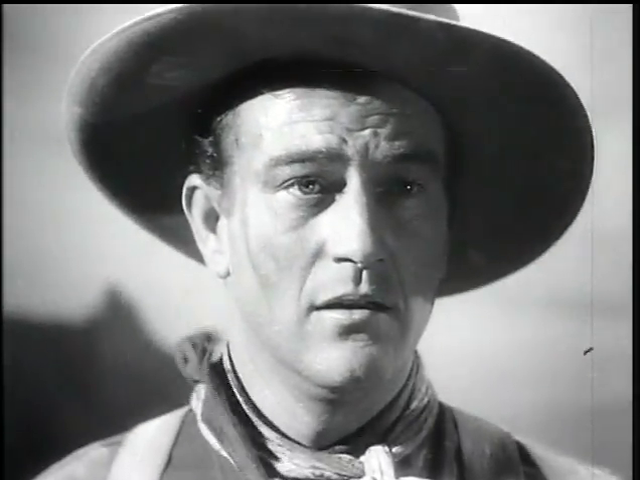

John Wayne as Ringo is the seventh passenger, he is “lucky seven”. We meet him beyond the boundary of the town and across the river because he is the true man of the West. His open honest face and easy smile show him for what he is, a cowboy. Now contrast Ringo’s face in image #5 with that of the banker, Gatewood in image #2. Which face do you trust? Again, Ford is letting his camera tell us who his charters are. Gatewood, we know, is actually a thief. He is stealing all the money from his own bank. Money that belongs to the people who trusted him with their money, working men like Ringo, Buck and Curly.
Honest as his face may be, we also know that Ringo is an “outlaw”, a man who has broken the law. Gatewood says “So, you are the notorious Ringo Kid”. When Doc asks what became of Ringo’s brother Ringo tells him “he was murdered”. We now have a hint about why Ringo became an outlaw. We will learn that Ringo is seeking revenge for the murder of his father and brother. But, Ringo is not the only one on the stagecoach who is seeking something or who will unexpectedly find something or who has a secret. That concludes lecture #3.